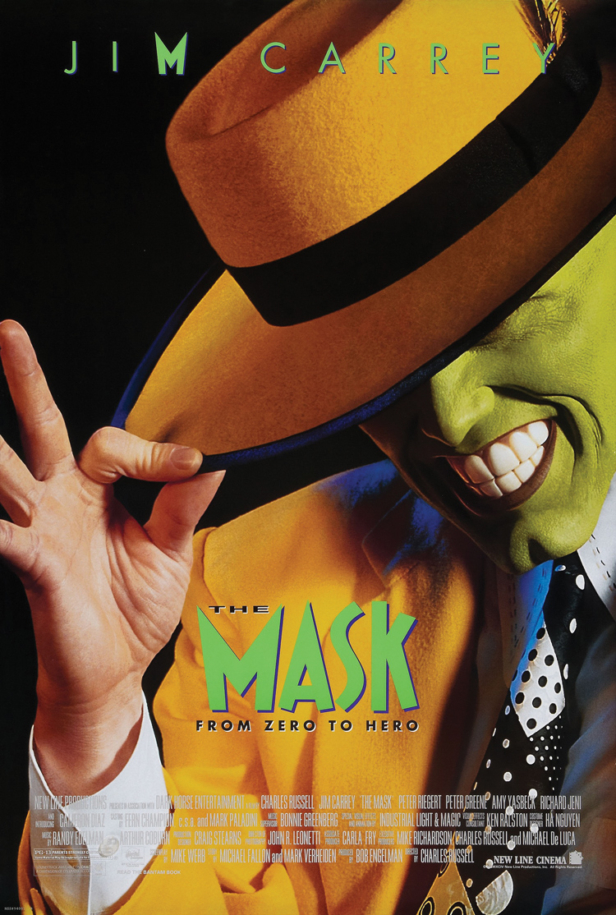“We knew we were doing something special,” smiles Chuck Russell, director of 1994’s madcap comedy The Mask. “The original concept was to take Jim Carrey and through physical comedy tell a story that would be universal – and it worked beyond my wildest dreams.”
26 years on, the legacy and success of Russell’s zero-to-hero tale of timid Edge City bank clerk Stanley Ipkiss (Carrey) and his transformation into a green-headed hero thanks to a magical Norse mask is clear to see. Not only did it rocket Carrey into instant overnight acclaim but it also helped to write the rulebook for the burgeoning CGI boom. Back in the early Nineties, however, it was far from a safe bet. Based on the Dark Horse comic, Ipkiss and his unleashed ID were more killer than cartoon when New Line began developing their story for the big screen. It wasn’t until Russell hired screenwriter Mike Werb to pen a lighter take tailored to the hyperactive talents of a then-unknown Carrey that The Mask we know today emerged.
“It was quite violent,” says Werb of the original comic. “Stanley Ipkiss kills several policeman in the first installment. After some more aggressive, true-to-the-comic takes, the director and studio wanted more of a family entertainment comedic look,” he tells us. “It became a sort of romantic comedy.”
For Russell, these sinister early versions reminded him of a character he’d worked with before: “I thought it was too much like Freddy Krueger,” he admits, recalling his work on 1987’s A Nightmare On Elm Street III: Dream Warriors. “It was a little too dark. The original comic was ‘Splatterpunk’– it was two funny lines, then The Mask reaches into his magic pocket, pulls out an axe and kills everybody,” he explains. “I had a vision of something that I thought was a lot more inspired. I’d seen Jim Carrey’s stand-up at The Comedy Store and I thought he was beyond brilliant – so I said let’s develop this as a comedy for Jim.”
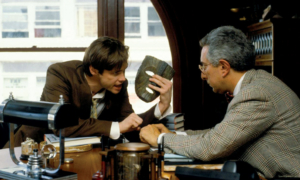
With their genre swapped, Werb set to work on a new script. First task: controlling the crazy. “One thing I noticed from earlier drafts was that it was chaotic from the get-go,” recalls the screenwriter. “There needed to be some rules and contrast. One of the things I tapped into was my own hideous life in middle-school and high-school and feeling like I was too nice or empathetic for a very aggressive and competitive world. I thought: let’s create a person who isn’t actualising his passion,” he says on the differences between Ipkiss and his amped-up alter-ego. Next came Carrey, whose potential involvement shaped the story even further: “If I remember correctly, Chuck said he wasn’t going to make the movie unless Jim Carrey was in it,” reveals Werb. “He sent me some stand-up tapes and I immediately fell in love with him. It had to be this guy. There was no other person who could play this role – so I just tried to channel him as much as possible while keeping that balance.”
By the time Russell met with Carrey during pre-production, he had a completed script in-hand but with the future-star’s movie Ace Ventura: Pet Detective still unreleased, he was no guarantee. “He understood that I got his humour and had developed it specifically for him but Jim himself was a bit of a hard sell,” says Russell on New Line’s reaction – they wanted Robin Williams. “Robin was a very big star, New Line was a small company and it was a low budget film – we couldn’t afford Robin even if he was interested,” he says. “With Jim, I knew the sky was the limit with comedy.” Russell persisted, eventually convincing New Line to take a risk on not just one unknown lead – but two. “I was focused on getting Cameron Diaz that role,” says the director on casting Coco Bongo dancer and Stanley’s love-interest Tina Carlyle. “Jim was better with Cameron in his auditions and rehearsals, the two of them lit-up when they did scenes together,” he smiles. “I didn’t blame New Line for being reluctant to give her a lead role – she’d never acted before at all.”
Leading roles cast, Russell began production – and while Carrey managed to contain his energy to suit Werb’s tonal tightrope, when the mask was on, all bets were off. “I had to get Jim to commit to doing more or less a straight romantic comedy when he played the part of Stanley Ipkiss,” Russell explains, “but when he put on the mask, I promised I’d take him further with physical comedy than he’d ever been before.” Speaking of which – to transform Carrey into a living cartoon Russell drew from a mixture of experimental practical effects, the limited CGI animation that was available at the time and the star’s infamous malleability. “I remember Chuck saying that Jim Carrey saved us hundreds of thousands – if not millions – of dollars,” laughs Werb on Carrey’s ability to give animation a run for its money. “Because of Jim’s facial maneuvering and general comic timing, we were able to not have quite as many Industrial Light and Magic effects,” he adds. “It was remarkable.”
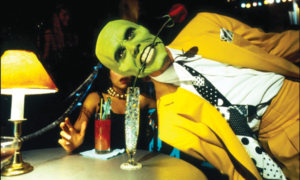
Russell talks us through the practicality of bringing Carrey’s oversized green-head to life: “I didn’t want to cover up or replace Jim’s performance. There was a danger that had me on edge, which was: if we cover Jim Carrey’s face in latex and lose any degree of the animation that’s natural to him, that would be a crime,” he admits, “yet I needed to do this amazing head that he transforms into for The Mask.” The solution? Keep things light: “I suggested we build off the bony parts of Jim’s face – it was technical but it worked. We used new materials to make a number of small appliances that were very flexible so the make-up blended together to the point where there were some areas where there was still skin intact, so you got all that facial animation,” reveals Russell. “It could have easily failed – because up to that point, I’d never seen latex face makeup that had that look. In fact, it’s rare now.
“Once we had the sculpted head where it was flexible for Jim’s expressions, we tried different sizes of teeth to look like the comic book character,” continues the director. “Jim’s a master of physical comedy, so we got some really large teeth and he was able to speak naturally through them. I had green contact lenses made and I thought for sure I was going to use them – but when we added the lenses we lost Jim Carrey’s soul a little bit. He looked like a demon. With it looking so scary, I thought: let’s use it for the bad guy instead.”
Practical effects aside, Werb and Russell looked to classics from the golden age of animation to inspire The Mask’s eye-popping visuality. “I love Tex Avery and still watch Tom And Jerry cartoons,” smiles Werb, on the thought-process behind the character’s elasticity. “All of that stuff was definitely part of my childhood.”
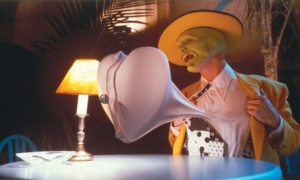
Of course, Ipkiss and his gangster nemesis Dorian (Peter Greene) weren’t the only people to don the Mask. “We loved that dog,” smiles Russell when asked about shooting with The Mask’s canine co-star Milo (real name Max). “When he put his head in the mask, it’s just terrific. He was a very happy dog and I think you can see that in the film. Jim is a wonderful improviser too so a lot of the best stuff was the dog’s personality and Jim reacting to it. They weren’t necessarily trained tricks,” he reveals. “I’m an animal lover – I love that relationship and I wanted that in The Mask because I thought it’d make Stanley so much more likeable – and it did. We use to joke that some of the actors had a harder time hitting their marks than the dog,” laughs Russell. “He was a pro. His double was his mother and I always said he did it out of respect for his mom. He got all his takes right and was a legit cast-member.”
When The Mask finally hit screens in July 1994, it exploded with the same ferocious energy as its green-faced star. Russell and Werb’s risk-taking and hard work had paid off; the film went on to earn a whopping $350 million worldwide, making it the second highest grossing superhero film at that time behind Tim Burton’s Batman, and it introduced audiences to Diaz, a true star-in-the-making.
For Carrey, the movie marked the middle-part of a trilogy of releases in 1994 (alongside Ace Ventura and Dumb And Dumber) that sent him stratospheric, cementing his status as a bonafide movie star. “I think it’s fair to say that Ace Ventura made Jim a national star and The Mask made him a global star,” suggests Russell. “People were roaring with laughter – they’d never seen anything like it in their lives,” he adds, recalling the film’s first public screening at Cannes Film Festival’s Le Marché du Film. “It was a totally unexpected treat and the most marvelous screening I ever had in my life. It was mind blowing.”
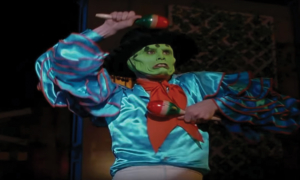
As the film rolled out across the world, reaction to it only grew stronger. “They turned the Samuel Goldwyn Theater into the Edge City Bank and that was just a blast,” recalls Werb of the film’s meta LA premiere. “That weekend I went out with some friends and just stalked movie theatres. I sat in and listened to audience reaction – it was pretty thrilling,” he smiles. “The film helped to give me a lot of confidence and writing that script actually helped me come out of my shell – a bit like the transition Stanley goes through into being more fearless and not so concerned about what other people think. I’m glad it’s held up.”
For Russell, The Mask’s impact and endurance is similarly meaningful: “I heard laughter all over the world and saw that it did work in every language. Cameron was loved and Jim was a new star. To me, it was a hopeful proof-of-concept that we all laugh at the same thing. We all want to see a zero become a hero and we’re a lot more alike than we know. The significance of The Mask to me was that people should go for their creative vision,” says Russell. “Going out on a limb can sometimes lead to very successful things.”
The Mask is available on Blu-ray from WHV.
